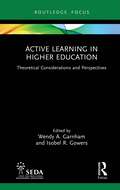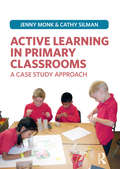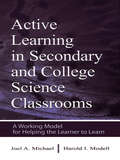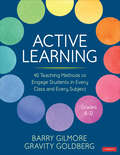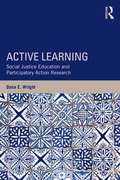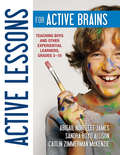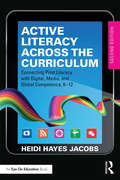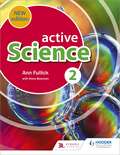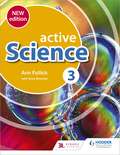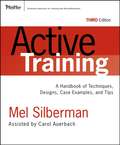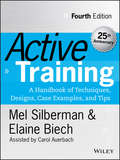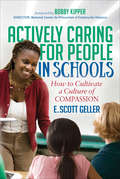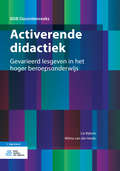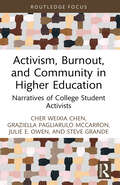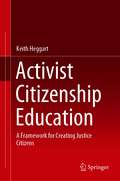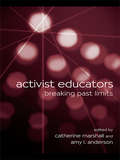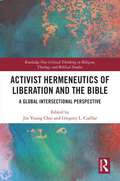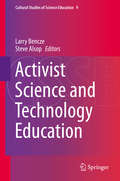- Table View
- List View
Active Learning in Higher Education: Theoretical Considerations and Perspectives (SEDA Focus)
by Wendy A. GarnhamThis insightful new book explores perspectives on active learning as creative discovery, conceptualisations of active learning spaces and transitions from theoretical approaches to active learning practice. It draws on the experiences of academics, learning technologists and clinical practitioners, and invites the reader to think about our conceptualisations of active learning and to move beyond mere demonstrations of its effectiveness. With contributions from academics and NHS practitioners, this publication will make a unique contribution to the literature that increasingly points to the value, impact and reach of active learning pedagogy. It importantly addresses the need for active learning, highlighting some of the many theoretical issues that active learning raises through three broad lenses:- The idea of active learning as creative play- The use of theoretical models in designing active learning- The transition from active learning theory to practiceAimed at anyone with an interest in active learning as a pedagogical approach, Active Learning in Higher Education provides a starting point for further discussion and development of pedagogical theory, becoming an essential read for educators, school leaders as well as researchers in the field of education.
Active Learning in Primary Classrooms: A Case Study Approach
by Jenny Monk Catherine SilmanWhat do they mean by Active Learning? How can you inspire children to engage fully in their learning? How can you plan and organise a curriculum that ensures that children are actively involved in the learning process?This brand new text not only explores and examines the concept of active learning, but demonstrates how every teacher, new or experienced, can translate theory into practice and reap the rewards of children actively engaged in their own learning in the classroom. Central to the book is the series of extended case studies, through which the authors highlight examples of effective teaching and learning across the whole primary curriculum. They provide practical examples of planning, teaching and assessing to encourage, inspire and give confidence to teach in creative, integrated and exciting ways.
Active Learning in Secondary and College Science Classrooms: A Working Model for Helping the Learner To Learn
by Joel Michael Harold I. ModellThe working model for "helping the learner to learn" presented in this book is relevant to any teaching context, but the focus here is on teaching in secondary and college science classrooms.Specifically, the goals of the text are to: *help secondary- and college-level science faculty examine and redefine their roles in the classroom; *define for science teachers a framework for thinking about active learning and the creation of an active learning environment; and *provide them with the assistance they need to begin building successful active learning environments in their classrooms. Active Learning in Secondary and College Science Classrooms: A Working Model for Helping the Learner to Learn is motivated by fundamental changes in education in response to perceptions that students are not adequately acquiring the knowledge and skills necessary to meet current educational and economic goals. The premise of this book is that active learning offers a highly effective approach to meeting the mandate for increased student knowledge, skills, and performance. It is a valuable resource for all teacher trainers in science education and high school and college science teachers.
Active Learning: 40 Teaching Methods to Engage Students in Every Class and Every Subject, Grades 6-12 (Corwin Teaching Essentials)
by Gravity Goldberg Barry GilmoreTried and true teaching strategies to boost student engagement. Students need to be actively engaged to learn—intellectually curious, physically active, and emotionally involved in collaborative work that builds their capacity for empathy. What can teachers do to instill these elements in the classroom? Active Learning: 40 Teaching Methods To Engage Students In Every Class and Every Subject is the actionable tool every new and veteran teacher needs to construct dynamic learning experiences for students. This hands-on, easy-to-use guide features 40 carefully curated, high-impact teaching strategies that target learning tools, collaboration structures, reading and writing routines, assessment opportunities and more. It includes: Step-by-step teaching strategies that can be mastered quickly and implemented in any order Tools to help teachers identify the most pressing classroom needs and determine which methods to try first Nine instructional structures including essential questions, strategy groups, stations, and simulations Real-world examples, tips, templates, and other supportive resources that offer guidance for each method, identify common challenges, and detail next steps Whether tweaking your existing strategies or finding new moves that will quickly become your own, this is your go-to guide for designing active, engaging learning experiences for students.
Active Learning: 40 Teaching Methods to Engage Students in Every Class and Every Subject, Grades 6-12 (Corwin Teaching Essentials)
by Gravity Goldberg Barry GilmoreTried and true teaching strategies to boost student engagement. Students need to be actively engaged to learn—intellectually curious, physically active, and emotionally involved in collaborative work that builds their capacity for empathy. What can teachers do to instill these elements in the classroom? Active Learning: 40 Teaching Methods To Engage Students In Every Class and Every Subject is the actionable tool every new and veteran teacher needs to construct dynamic learning experiences for students. This hands-on, easy-to-use guide features 40 carefully curated, high-impact teaching strategies that target learning tools, collaboration structures, reading and writing routines, assessment opportunities and more. It includes: Step-by-step teaching strategies that can be mastered quickly and implemented in any order Tools to help teachers identify the most pressing classroom needs and determine which methods to try first Nine instructional structures including essential questions, strategy groups, stations, and simulations Real-world examples, tips, templates, and other supportive resources that offer guidance for each method, identify common challenges, and detail next steps Whether tweaking your existing strategies or finding new moves that will quickly become your own, this is your go-to guide for designing active, engaging learning experiences for students.
Active Learning: Social Justice Education and Participatory Action Research (Teaching/Learning Social Justice)
by Dana E. WrightWhile many educators acknowledge the challenges of a curriculum shaped by test preparation, implementing meaningful new teaching strategies can be difficult. Active Learning presents an examination of innovative, interactive teaching strategies that were successful in engaging urban students who struggled with classroom learning. Drawing on rich ethnographic data, the book proposes participatory action research as a viable approach to teaching and learning that supports the development of multiple literacies in writing, reading, research and oral communication. As Wright argues, in connecting learning to authentic purposes and real world consequences, participatory action research can serve as a model for meaningful urban school reform. After an introduction to the history and demographics of the working-class West Coast neighborhood in which the described PAR project took place, the book discusses the "pedagogy of praxis" method and the project’s successful development of student voice, sociopolitical analysis capacities, leadership skills, empowerment and agency. Topics addressed include an analysis and discussion of the youth-driven PAR process, the reactions of student researchers, and the challenges for adults in maintaining youth and adult partnerships. A thought-provoking response to current educational challenges, Active Learning offers both timely implications for educational reform and recommendations to improve school policies and practices.
Active Lessons for Active Brains: Teaching Boys and Other Experiential Learners, Grades 3-10
by Caitlin Zimmerman Mckenzie Sandra Boyd Allison Abigail Norfleet JamesLearn what to do when your students' feet just can't keep still.If you have had enough of repeating yourself to students who aren't listening, try a little less talk and a lot more action. The authors of Active Lessons for Active Brains have assembled an indispensable, ready-to-use collection of mathematics, language arts, science, and classroom management strategies to focus a classroom full of energetic minds. Designed for active, hands-on learners-whether male or female-the text provides more than 70 specific lesson plans for addressing students' common challenges, already differentiated to match their experiential learning style.The many benefits of using this book include: A more orderly classroom Enhanced capacity to focus on tasks Improved retention of subject matter Increased student engagementThis book contains a wealth of examples, visuals, and material that can be easily reproduced in the classroom. Suitable for upper elementary to high school students, lesson plans can be readily adapted to suit any curriculum.
Active Lessons for Active Brains: Teaching Boys and Other Experiential Learners, Grades 3–10
by Sandra Boyd Allison Abigail Norfleet James Caitlin Zimmerman McKenzieWhat to do when their feet just can’t keep still Capture students’ attention with less talk and more action. The authors follow the best-selling Teaching the Male Brain andTeaching the Female Brain with this collection of mathematics, language arts, science, and classroom management strategies. Applicable to male and female active learners, the research-based text provides a wealth of examples, visuals, and material that can be easily reproduced to address experiential learners’ common challenges. The many benefits include: Increased student engagement Improved retention of subject matter Enhanced capacity to focus on tasks A more orderly classroom
Active Literacy Across the Curriculum: Connecting Print Literacy with Digital, Media, and Global Competence, K-12
by Heidi Hayes JacobsHelp students become more confident and successful readers, writers, and thinkers in today’s world. In this new edition of a bestseller, highly acclaimed author and speaker Heidi Hayes Jacobs offers practical ideas for closing the literacy gap by teaching classic literacies (reading, writing, speaking, and listening) along with essential new literacies (digital, media, and global). The expanded second edition features Heidi’s latest work on the new literacies and provides enhanced versions of strategies designed to help educators integrate critical language skills into their daily operational curriculum. These strategies include: Revising and expanding the role of all teachers so that they see themselves as classical language and contemporary literacy teachers; Separating vocabulary into three distinctive types with distinctive instructional approaches to sustain and extend independent language development; Building creative and visual notetaking and sketchnoting strategies; Designing media projects for every class level and employing a consistent editing and revision policy for writing assignments; Using a formal approach to develop speaking skills through four discussion types to increase civil public discourse; Employing direct technical instruction that promotes the use of the human voice and body as a speaking and communication instrument; Using Curriculum Mapping to develop formal benchmark assessments for active literacy and new literacy cultivation in every subject and on every level. Each chapter is focused on a specific strategy and includes practical examples so you can easily implement the ideas, no matter what grade level or subject area you teach.
Active Science 1 new edition (Active Science #1)
by Ann FullickBuild and assess your students' Science knowledge, understanding and skills through better learning techniques, ensuring a solid foundation for further science study.- Confidently meet the requirements of the Trinidad & Tobago, Barbados, Guyana and OECS curricula and CXC's CCSLC syllabus with detailed mapping grids available for free online. - Inspire students to progress with this contemporary take on Science that includes topics such as environmental science and green issues.- Engage students through an active learning approach with hands-on activities to promote learning through practice.- Prepare students for moving up to CSEC® level science with activities developed to bridge the gap between lower secondary and CSEC® level.
Active Science 1 new edition (Active Science Ser.)
by Ann FullickBuild and assess your students' Science knowledge, understanding and skills through better learning techniques, ensuring a solid foundation for further science study.- Confidently meet the requirements of the Trinidad & Tobago, Barbados, Guyana and OECS curricula and CXC's CCSLC syllabus with detailed mapping grids available for free online. - Inspire students to progress with this contemporary take on Science that includes topics such as environmental science and green issues.- Engage students through an active learning approach with hands-on activities to promote learning through practice.- Prepare students for moving up to CSEC® level science with activities developed to bridge the gap between lower secondary and CSEC® level.
Active Science 2 new edition (Active Science #2)
by Ann FullickBuild and assess your students' Science knowledge, understanding and skills through better learning techniques, ensuring a solid foundation for further science study.- Confidently meet the requirements of the Trinidad & Tobago, Barbados, Guyana and OECS curricula and CXC's CCSLC syllabus with detailed mapping grids available for free online. - Inspire students to progress with this contemporary take on Science that includes topics such as environmental science and green issues.- Engage students through an active learning approach with hands-on activities to promote learning through practice.- Prepare students for moving up to CSEC® level science with activities developed to bridge the gap between lower secondary and CSEC® level.
Active Science 2 new edition (Active Science Ser.)
by Ann FullickBuild and assess your students' Science knowledge, understanding and skills through better learning techniques, ensuring a solid foundation for further science study.- Confidently meet the requirements of the Trinidad & Tobago, Barbados, Guyana and OECS curricula and CXC's CCSLC syllabus with detailed mapping grids available for free online. - Inspire students to progress with this contemporary take on Science that includes topics such as environmental science and green issues.- Engage students through an active learning approach with hands-on activities to promote learning through practice.- Prepare students for moving up to CSEC® level science with activities developed to bridge the gap between lower secondary and CSEC® level.
Active Science 3 new edition
by Ann FullickBuild and assess your students' Science knowledge, understanding and skills through better learning techniques, ensuring a solid foundation for further science study.- Confidently meet the requirements of the Trinidad & Tobago, Barbados, Guyana and OECS curricula and CXC's CCSLC syllabus with detailed mapping grids available for free online. - Inspire students to progress with this contemporary take on Science that includes topics such as environmental science and green issues.- Engage students through an active learning approach with hands-on activities to promote learning through practice.- Prepare students for moving up to CSEC® level science with activities developed to bridge the gap between lower secondary and CSEC® level.
Active Science 3 new edition (Active Science #3)
by Ann FullickBuild and assess your students' Science knowledge, understanding and skills through better learning techniques, ensuring a solid foundation for further science study.- Confidently meet the requirements of the Trinidad & Tobago, Barbados, Guyana and OECS curricula and CXC's CCSLC syllabus with detailed mapping grids available for free online. - Inspire students to progress with this contemporary take on Science that includes topics such as environmental science and green issues.- Engage students through an active learning approach with hands-on activities to promote learning through practice.- Prepare students for moving up to CSEC® level science with activities developed to bridge the gap between lower secondary and CSEC® level.
Active Training
by Melvin L. Silberman Carol AuerbachSince 1990, Mel Silberman's classic book, Active Training, has been a runaway best-seller for trainers at all levels and a popular text for university level courses in adult education and training. The active training method--which turns the spotlight away from the instructor and put the emphasis on the learner--has emerged over time as a proven and reliable method for enhancing involvement, learning, and change.The third edition of Active Training, provides a thorough introduction to the core principles of active training design and delivery and includes a wealth of examples, tips, and techniques. The book has been revised to reflect the latest trends in workforce training and key sections, such as assessment and evaluation, have been thoroughly updated. In addition, a completely new chapter has been included to cover the design of active training for e-learning and online applications.
Active Training
by Elaine Biech Melvin L. SilbermanThe all-time bestselling training handbook, updated for new technologies and roles Active Training turns instructional design on its head by shifting the emphasis away from the instructor, and on to the learner. Comprehensively updated to reflect the many developments in the field, this new fourth edition covers the latest technologies and applications, the evolving role of the trainer, and how new business realities impact training, advancing new evidence-based best practices for new trainer tasks, skills, and knowledge. Up to date theory and research inform the practical tips and techniques that fully engage learners and help them get the most out of sessions, while updated workplace examples and revised templates and worksheets help bring these techniques into the classroom quickly. You'll gain insight into improving training evaluation by using Return on Expectations (ROE), learn how to extend the value of training programs through transfer of learning, and develop fresh, engaging methods that incorporate state-of-the-art applications. Active Training designs offer just the right amount of content; the right balance of affective, behavioral, and cognitive learning; a variety of approaches; real-life problem solving; gradual skill-building; and engaging delivery that uses the participants' expertise as a foundation for learning. This book is the classic guide to employing Active Training methods effectively and appropriately for almost any topic. Learn how the trainer's role has changed Engage learners through any training delivery method Inspire collaboration and innovation through application Overcome the challenges trainers face in the new business environment Active Training methods make training sessions fun, engaging, relevant, and most importantly, effective. Participants become enthusiastic about the material, and view sessions as interesting challenges rather than as means to fulfill requirements. To bring these widely endorsed methods into your training repertoire, Active Training is the complete practical handbook you need.
Actively Caring for People in Schools: How to Cultivate a Culture of Compassion
by E. Scott GellerSeven research-based lessons from psychology—the science of human experience—inspire the development of an actively caring for people (AC4P) culture. The education/training purpose: to enhance long-term positive and sustainable relations between teachers, students, school administrators, and SROs, and in turn cultivate an optimal teaching/learning climate and prevent interpersonal conflict and bullying behavior. Both education and training are provided. Each research-based principle for AC4P intervention is explained and followed by questions or scenarios to facilitate group discussion. Behavioral exercises are given to practice each principle and receive supportive and corrective feedback for continuous improvement.
Actively Seeking Inclusion: Pupils with Special Needs in Mainstream Schools (Studies In Inclusive Education Ser.)
by Julie AllanFirst Published in 2004. Routledge is an imprint of Taylor & Francis, an informa company.
Activerende didactiek: Gevarieerd lesgeven in het hoger beroepsonderwijs (BDB Docentenreeks)
by Lia Bijkerk Wilma HeideAlle docenten die lesgeven in het hbo moeten aan de Basiskwalificatie Didactische Bekwaamheid (BDB) voldoen. Dit boek is een hulpmiddel voor docenten om deze kwalificatie te verkrijgen en biedt inspiratie om te werken aan de competenties 'ontwerpen' en 'doceren'. Het uitgangspunt in dit boek is de didactische visie die ook beschreven is in het boek 'Activerend opleiden. Didactiek voor resultaatgericht beroepsonderwijs' van dezelfde auteurs. Deze visie is nu verder geoptimaliseerd. Activerende didactiek is een methode van lesgeven die inspeelt op verschillen tussen studenten. Het accent in dit boek ligt op de didactiek met betrekking tot het ontwerpen en uitvoeren van onderwijs en is opgezet vanuit praktische vragen waarmee docenten in het hoger beroepsonderwijs vaak geconfronteerd worden. Het gaat om vragen als: Hoe bereid ik mijn lessen, trainingen of workshops voor? Hoe vind of maak ik materiaal voor mijn lessen? En, hoe kan ik studenten uitdagen? Activerende didactiek maakt het onderwijs meer gedifferentieerd, waardoor de talenten van studenten beter benut worden. De vele praktische voorbeelden en tips in dit boek zijn afkomstig uit de praktijk van verschillende hogescholen en toegespitst op de BDB. De reflectievragen en portfolio-opdrachten helpen bij het inschatten van de eigen bekwaamheid op het gebied van ontwerpen en doceren. Activerende didactiek - Gevarieerd lesgeven in het hoger beroepsonderwijs is in eerste instantie bestemd voor hbo-docenten. Daarnaast kunnen ook mbo-docenten, docenten voortgezet- en basisonderwijs, trainers, facilitatoren, bedrijfsopleiders, praktijkopleiders, studieloopbaanbegeleiders, mentoren, coaches en docenten betrokken bij volwasseneneducatie met dit boek werken aan hun didactische kwaliteiten.
Activism, Burnout, and Community in Higher Education: Narratives of College Student Activists (Routledge Research in Higher Education)
by Cher Weixia Chen Graziella Pagliarulo McCarron Julie E. Owen Steve GrandeThis illuminating volume explores the often-overlooked relationship between college student activism and well-being, drawing on a multi-phase study that explores college students’ perspectives on how their activism impacts their well-being.Based on a study of 119 US college students, the authors share their findings through a constructivist, qualitative lens, revealing three key themes: The link between student activism and students’ identities, the non-negotiable time costs of activism and associated burnout, and the ways that students and higher education can benefit from a different way of considering university and community care. With scholarship exploring the connections between college student activism and well-being still nascent, this book pioneers a fresh understanding of the intersection between student activism and well-being, amplifying authentic student voices throughout and offering practical recommendations for student support. Through a combination of personal narratives, data analysis, and expert commentary, it explores what inspires college student activists to work to create a more just and equitable society, as well as the prevalence of burnout and the tools students use to mitigate their struggles and improve their own well-being.This book will be suitable for both undergraduate and graduate students as well as scholars, practitioners, and professionals in the larger higher education and social justice community.
Activist Citizenship Education: A Framework for Creating Justice Citizens
by Keith HeggartThis book explores alternative models of civics and citizenship education. Specifically, it uses Justice Citizens, a participatory research and film-making project, as a tool to examine young people’s ideas about active citizenship and participation in public spaces. It introduces a framework that seeks to explore the diverse and apparently contradictory nature of young people’s active citizenship. The framework draws on complexity theory combined with critical pedagogy and democratic education to formulate an approach to developing active citizenship among young people. This approach extends theories of both critical pedagogy and education for citizenship, and by doing so seeks to explain the variegated nature of young people’s engagement with civil society. This book contains a valuable repository of ideas and resources for application for teachers to use in schools and classrooms. Academics engaged in initial teacher education, at both primary and secondary levels, will find the framework of use when describing the importance and new approaches to civics and citizenship education within the current school and policy environments.
Activist Educators: Breaking Past Limits (Teaching/Learning Social Justice)
by Catherine Marshall Amy L. AndersonTaking an active stand in today's conservative educational climate can be a risky business. Given both the expectations of the profession and the challenge of participation in social justice activism, how do educator activists manage the often competing demands of professional and activist commitments? Activist Educators offers a view into the big picture of assertive idealistic professionals’ lives by presenting rich qualitative data on the impetus behind educators’ activism and the strategies they used to push limits in fighting for a cause. Chapters follow the stories of educator activists as they take on problems in schools, including sexual harassment, sexism, racism, reproductive rights, and GLBT rights. The research in Activist Educators contributes to an understanding of professional and personal motivations for educators’ activism, ultimately offering a significant contribution to aspiring teachers who need to know that education careers and social justice activist causes need not be mutually exclusive pursuits.
Activist Hermeneutics of Liberation and the Bible: A Global Intersectional Perspective (Routledge New Critical Thinking in Religion, Theology and Biblical Studies)
by Jin Young Choi Gregory L. CuéllarInspired by the current political moment around the globe in which uprisings, protests, revolutions, and movements are on the rise, this book examines the intersections between the Bible and activism. It does this by showcasing intersectional readings of the Bible as an activist act and a tool for activism; historicizing the uses of the Bible within activist/freedom movements around the globe; and offering activist approaches to teaching the Bible.Each chapter in this volume provides a critical and substantive response from the discipline of Biblical Studies to global political trends. International in scope, with contributors from Africa, Asia, Caribbean, Europe, Latin America, Oceania and the United States, they address themes such as gender politics, racial injustices, violence toward women, political resistance, and activist hermeneutics and pedagogies. Together they harness the intellectual energies of minoritized Biblical scholars in a nonessentialist manner to reflect on the Bible as a tool for liberating social and political change. Reflecting on the activist potential of the Bible, this book will be of keen interest to scholars in Biblical Studies, Political Theology, and Religious Studies.
Activist Science and Technology Education (Cultural Studies of Science Education #9)
by Larry Bencze Steve AlsopThis collection examines issues of agency, power, politics and identity as they relate to science and technology and education, within contemporary settings. Social, economic and ecological critique and reform are examined by numerous contributing authors, from a range of international contexts. These chapters examine pressing pedagogical questions within socio-scientific contexts, including petroleum economies, food justice, health, environmentalism, climate change, social media and biotechnologies. Readers will discover far reaching inquiries into activism as an open question for science and technology education, citizenship and democracy. The authors call on the work of prominent scholars throughout the ages, including Bourdieu, Foucault, Giroux, Jasanoff, Kierkegaard, Marx, Nietzsche, Rancière and Žižek. The application of critical theoretical scholarship to mainstream practices in science and technology education distinguishes this book, and this deep, theoretical treatment is complemented by many grounded, more pragmatic exemplars of activist pedagogies. Practical examples are set within the public sphere, within selected new social movements, and also within more formal institutional settings, including elementary and secondary schools, and higher education. These assembled discussions provide a basis for a more radically reflexive reworking of science and technology education. Educational policy makers, science education scholars, and science and technology educators, amongst others, will find this work thought-provoking, instructive and informative.
